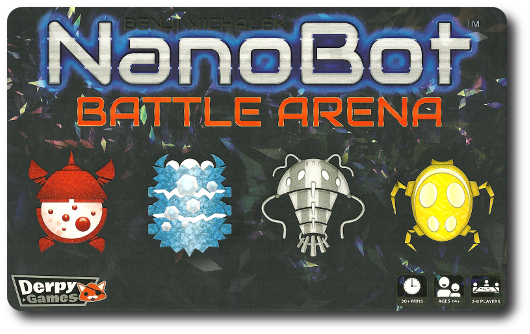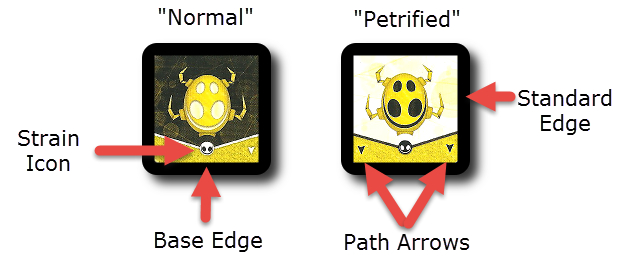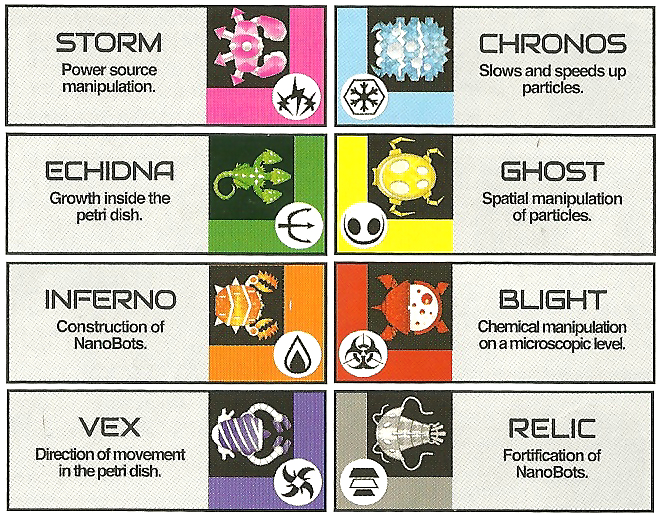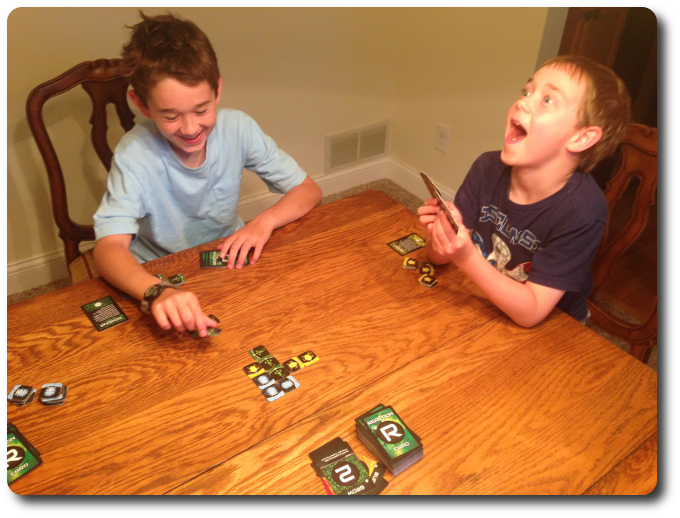
The Basics:
- For ages 6 and up (publisher suggests 14+)
- For 2 to 8 players
- Approximately 30 minutest to complete
Geek Skills:
- Counting & Math
- Logical & Critical Decision Making
- Reading
- Pattern/Color Matching
- Strategy & Tactics
- Hand/Resource Management
Learning Curve:
- Child – Easy
- Adult – Easy
Theme & Narrative:
- Size doesn’t matter when you can swarm
Endorsements:
- Gamer Geek mixed!
- Parent Geek approved!
- Child Geek approved!
Purchase:
Overview
The belief that “bigger is better” is held by many, but it’s not necessarily an accurate statement. Nanobots are small enough to travel through the human body next to red blood cells and have firepower equal to that of an M1A2 Abrams main battle tank (albeit on a smaller scale). Size, it turns out, is all relative.
NanoBot Battle Arena, designed by Benji Michalek and published by Derby Games, is comprised of 96 Reaction cards, 15 “Blight Strain” NanoBot tiles, 15 “Chronos Strain” NanoBot tiles, 15 “Inferno Strain” NanoBot tiles, 15 “Echidna Strain” NanoBot tiles, 15 “Vex Strain” NanoBot tiles, 15 “Ghost Strain” NanoBot tiles, 15 “Storm Strain” NanoBot tiles, and 15 “Relic Strain” NanoBot tiles for a total of 120 NanoBot tiles. The tiles are thick and very durable, being just the right size to easily pick up without taking up a lot of table space. The cards are as thick and as durable as your standard playing card.
Prepping the Petri Dish
To set up the game, first separate the tiles by Strain type. Have each player select the Strain type of their choice or randomly distribute the Strains, one type per player (players can never share the same Strain type). The player takes the stack of Strain tiles and places it in front of them. This stack of unplayed tiles is referred to as the player’s “Cache”.
Second, take the Reaction deck of cards and organize them into piles based on the Reaction card’s Charge value (1, 2, and 3, respectively). Shuffle each pile individually and place them face-down.
Third, deal 1 “Charge value 3” Reaction card to each player, deal 2 “Charge value 2” Reaction cards to each player, and deal 3 “Charge value 1” Reaction cards to each player. All cards should be dealt face-down. The cards dealt are the start of the players’ hand. These cards should be kept hidden from opponents until played.
Fourth, merge the 3 Reaction card piles into one large deck and shuffle thoroughly. Place this deck of cards to one side of the playing area, face-down, and within easy reach of all the players. This is the Reaction card draw deck for the duration of the game. Leave room for a discard pile.
Fifth, draw and discard 1 Reaction card from the Reaction card draw deck, one at a time, until a Reaction card matches a player’s selected Strain type. This is the first player for the duration of the game.
That’s it for game set up. Time to get these little bots battling!
A Really Close Look at the NanoBots
Each nanobot is a robot so small that it takes a powerful microscope to view it. Players will quickly learn that size means nothing in this game, as each little nanobot is a powerhouse. Players will also have to learn how their nanobots work if they are to use them wisely.
A NanoBot tile has two sides: Normal and Petrified. The Normal side represents the Nanobot tile in its standard state. All NanoBot tiles enter the game with this side face-up. The Petrified state is a type of shield. It protects the NanoBot tile from all other nanobot Strain type abilities with the one exception of the “Relic” Strain type that can punch through Petrified NanoBot tiles. A state of petrification does not limit a player’s ability to manipulate or use their NanoBot tile.
The four sides of the NanoBot tile are also important. At the front of the NanoBot tile is the “Base Edge”. This indicates the NanoBot tile facing, line of sight (Path Arrows), and is used to restrict placement of other NanoBot tiles. The other sides of the NanoBot tile are referred to as “Standard Edges”.
Finally, each NanoBot tile has a Strain icon which is used to help determine if played Reaction cards are modified based on the Strain type they are played against.

Each Strain type has a unique ability that suggests how the player should use them strategically and tactically during the game. Each Strain and their ability is summarized here.

Micro Destruction
NanoBot Battle Arena is played in turns with no set number of turns per game. Each player’s turn is divided into phases. Each phase is summarized here.
Phase 1: Play 1 NanoBot Tile
The first action a player does on their turn is play 1 NanoBot tile to the playing area. The playing area should be in the middle and be large enough to allow players to build multiple rows and columns using the tiles. NanoBot tiles are always taken from the player’s Cache and played with the dark “Normal” side face-up.
The first NanoBot tile played can be placed anywhere in the playing area and be orientated in any direction. All new NanoBot tiles played from Cache must be placed adjacent, never diagonal, to other tiles to form a grid of vertical and horizontal rows. Additionally, the NanoBot tile can be placed next to any other NanoBot tile (even nanobots of a different Strain), but cannot be placed adjacent to an opponent’s NanoBot tile’s Base Edge. Only NanoBot tiles of the same Strain type can be connected there.
NanoBot Chains
A chain of NanoBots can be built by continually placing 1 NanoBot tile’s Standard Edge to another NanoBot tile’s Base Edge. The NanoBots must be of the same Strain type. Creating chains is the goal of the game and they also allow the player to control sections of the playing area. A chain could be as small as 1 NanoBot tile or as many NanoBot tiles as the player has initially in their Cache. Chains can also loop and fork, snaking their way in and around the game playing area. The rule book provides several visual examples, making it easy to understand just how complicated players could make the game for each other.
Phase 2: Play or Discard 1 Reaction Card
The player MUST play a Reaction card or discard a Reaction card to the discard pile. If the Reaction card is played, the player resolves the Reaction card’s effects. Once resolved, the Reaction card is sent to the discard pile. If the Reaction card is discarded, the effects are ignored.
Each Reaction card has a Charge value. This number indicates how many times the player can use the effect on the Reaction card if they play it instead of discarding it. How the player uses it is dependent on the Reaction card effect. For example, the “Blink” Reaction card allows the player to relocate 1 of their NanoBot tiles for every Charge on the Reaction card, while the “Freeze” Reaction card allows the player to temporarily remove 1 Reaction card per Charge from an opponent’s hand until the opponent’s next turn.

Note: A player is never required to use all the Charges supplied by the Reaction card. Additionally, a player can focus all the Reaction card’s effect on as many targets as they like, 1 per Charge. This gives the player a great deal of flexibility when it comes time to determining where best to use the Reaction card effect. They could focus on one opponent or target different individuals, for example.
There are 8 different affinity types of Reaction cards and Strains. If the affinity icon on the Reaction card matches the NanoBot tile Strain icon, it has an “affinity”. If the Reaction card played has an affinity with the player’s nanobot Strain type, the total Charge value is increased by +1. Of course, the opposite applies, as well. Any Reaction card played against an opponent who has an affinity with the Reaction card reduces the total number of available Charges by -1.
NanoBot tiles that are manipulated by Reaction cards could remain in play or be removed from the game. It’s possible that removed NanoBot tiles will break chains or even orphan other NanoBot tiles. Orphaned Nanobot tiles are no longer connected to the larger whole, but they can still be built on using the tile placement rules.
Note: The Type value identifies where the Reaction card can be played. Only “Power” type Reaction cards are provided in this version of the game.
Phase 3: Draw Cards
The player now draws as many cards as necessary from the Reaction card draw deck to bring their hand back up to 6 Reaction cards.
It’s now the next player’s turn.
Ending the Battle
The game comes to an immediate end when any player no longer has any NanoBot tiles in their Cache. The active player is not allowed to complete their turn or resolve their current turn phase.
Players now inspect the playing area to determine which player has the longest chain of NanoBot tiles. If a chain forks, the longest branch of that chain is the only one considered. The player with the longest chain wins the game. In the event of a tie, the player with the fewest NanoBot tiles still in their Cache wins.
Game Variant
For players looking for a deeper challenge and a longer game, several copies of NanoBot Battle Arena can be put together. Each player is still in control of 1 Strain type, but the number of tiles they might have to use could increase from 30 to 45 to 60 tiles in total. When additional copies of the game are put together, the only thing to change (other than the really large NanoBot chains) is how many tiles and cards are played, as well as the player’s turn. One additional phase is added and the number of actions taken per phase increases.
- Phase 1: Play 1 Reaction card
- Phase 2: Play 2 NanoBot tiles
- Phase 3: Play 2 Reaction cards
- Phase 4: Draw Cards
Players can also meld Reaction cards. If 2 Reaction cards are played with the same name at the same time by the same player, the Charge values of both cards are combined. This includes the affinity bonus or penalty.
To learn more about NanoBot Battle Arena, visit the game’s web page.
Final Word
This was a surprisingly easy game to teach to the Child Geeks. They understood the goal and how to go about playing the game within only a few minutes of explaining the rules. It’s worth noting that none of the Child Geeks thought the NanoBot tiles represented robots. According to one Child Geek, “These are aliens.” Not alien robots. Aliens. As in living creatures from another planet. Hardly makes a difference, but the Child Geeks kept going out of their way to get others to agree with them. What they also agreed on was the game’s challenge. They really enjoyed how the tiles could be manipulated or removed. One Child Geek said, “I think I like playing the Reaction cards more than placing the tiles.” The Reaction cards do give the player a lot to think about, but more importantly, a player is never without options. This is perhaps what the Child Geeks liked the best. Even if they were having a hard time creating a chain, they were never put in a corner. When all the battles were over, the Child Geeks voted to approve NanoBot Battle Arena.

One Child Geek yells in mock anger as his older brother slaps down a tile to the playing area
The Parent Geeks found NanoBot Battle Arena to be casual and light in game play, but also just heavy enough to keep them engaged from start to finish. The game’s relative short game play length and continually morphing battlefield made each turn something to watch, but that wasn’t necessarily a good thing. According to one Parent Geek, “I like this game, but I find it a bit exasperating how easy it is to break chains and mess with players.” Another Parent Geek said, “Tile placement is important, but to win the game, you need the right Reaction cards. I don’t see how you could win otherwise.” The Parent Geeks believed that NanoBot Battle Arena was best with no more than 3 players and perfect as a 2-player game. Perfect enough to get the Parent Geek vote of approval.
The Gamer Geeks liked the look of the game and the idea of the game, but couldn’t decide if any of that made it a good game. According to one Gamer Geek, “The game has all the right ideas, but falls down on its face too many times. If you have too many players, the game is a real mess.” Another Gamer Geek said, “This is a game you should only play with 2 players. If you play with more than that, it’s just a waste of time.” And by “waste of time”, the Gamer Geek meant that NanoBot Battle Arena went from an interesting light abstract tile placement game with strategic and tactical game play to a random and chaotic mess. When it came time to vote, half of the Gamer Geeks gave the game their approval, finding value in it when played with a small number of players. The other half rejected the game, finding it to be half the game it promised to be. As one Gamer Geek put it, “I wouldn’t buy a car that only went 20 miles per hour when it’s supposed to go 80 and I wouldn’t buy a game that can hold up to 8 players but is only playable with 2.” Fair enough.
NanoBot Battle Arena is a game that’s all about rolling with the proverbial punches. Nothing remains static as new tiles are placed and Reaction cards shuffle things about. When playing with smaller groups, the punches are hard enough to make you adjust your course and rethink your tactics, but the player can easily recover. In larger groups, that same punch is hard enough to knock you on your butt and force you to start over. The differences are not subtle, but it also strongly suggests that NanoBot Battle Arena is 2 games in one. For those who want a slower abstract game with light strategic and tactical game play, then NanoBot Battle Arena should be played with as few players as possible. For those who want a chaotic brawl where the last person left standing is determine by luck and timing, then play with 5 or more players. Both types of games provide unique types of fun, with strategic tile placement and “take that” player interaction found in both. Just don’t go thinking that the depth of the game is the same. Every time you add a player, the game loses its depth of play. Focus moves away from the care and concern of nanobot chains to destroying and hampering opponents as often as possible.
Which, yes, I know, sounds chaotic. But it really isn’t. The key to the game, be it with only 2 players or 8, is to drop tiles, petrify as quickly as possible, and protect your position. Chains of NanoBot tiles will be smaller, but there will be more chains to consider, as well. A player need only have the longest chain to win. The player’s efforts could be focused on 1 chain or several as a result.
I liked NanoBot Battle Arena, and really don’t mind the two different types of game play. Heck, I rather enjoy it. If I want a “serious game” of NanoBot Battle Arena, I play it as a 2-player game. If I just want to kill some time, I invite everyone to site down with me and attempt to break my awesome long chain of 3 NanoBot tiles (don’t laugh, I won a game with only 3 tiles once). Two games in one is right, but you only have to learn the rules of the game once. If NanoBot Battle Arena sounds like a game you’d be interested in, I encourage you to give it a try, but don’t judge the game until you’ve played it twice. Once with a friend and once with 7 other people who you may or may not be friends with.
This game was given to Father Geek as a review copy. Father Geek was not paid, bribed, wined, dined, or threatened in vain hopes of influencing this review. Such is the statuesque and legendary integrity of Father Geek.



